旅游英语大纲
旅游英语课程教学大纲
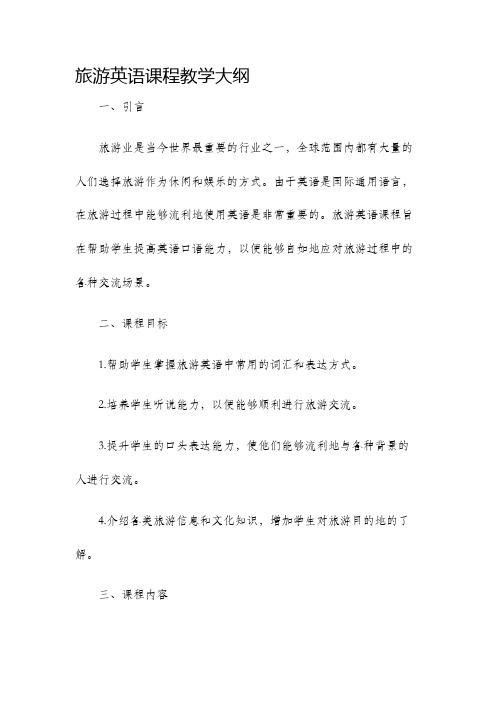
旅游英语课程教学大纲一、引言旅游业是当今世界最重要的行业之一,全球范围内都有大量的人们选择旅游作为休闲和娱乐的方式。
由于英语是国际通用语言,在旅游过程中能够流利地使用英语是非常重要的。
旅游英语课程旨在帮助学生提高英语口语能力,以便能够自如地应对旅游过程中的各种交流场景。
二、课程目标1.帮助学生掌握旅游英语中常用的词汇和表达方式。
2.培养学生听说能力,以便能够顺利进行旅游交流。
3.提升学生的口头表达能力,使他们能够流利地与各种背景的人进行交流。
4.介绍各类旅游信息和文化知识,增加学生对旅游目的地的了解。
三、课程内容Module 1: 旅游简介1. 旅游行业概述:介绍全球旅游业的规模和发展趋势。
2. 旅游地点介绍:学习如何用英语描述各类旅游目的地的特点和优势。
3. 旅游资源:学习如何描述各类旅游资源,并学习相关词汇和表达方式。
Module 2: 旅游准备1. 旅行计划:学习如何提问和回答有关旅行计划的问题。
2. 预订酒店和机票:学习如何预订酒店和机票,并处理相关的交流场景。
3. 带上必备物品:介绍旅行必备物品,并学习相关词汇和表达方式。
Module 3: 在旅途中1. 在机场和车站:学习与机场和车站工作人员交流的基本句型和用语。
2. 导航和交通:学习如何在陌生的地方使用英语寻找方向和使用公共交通工具。
3. 旅游中的应急处理:通过案例学习如何处理旅游过程中的紧急情况,并学习相关表达方式。
Module 4: 旅游活动1. 参观景点:学习如何用英语描述景点的特点和历史,并学习相关词汇和表达方式。
2. 体验当地文化:学习如何与当地人交流并了解当地文化的相关用语。
3. 美食与购物:学习如何点菜、购物和与服务员交流的相关用语。
四、教学方法1. 听力训练:通过听取旅游相关的对话和短文,提高学生的听力理解能力。
2. 口语练习:通过角色扮演和小组讨论等方式,让学生进行口语表达练习。
3. 阅读和写作练习:通过阅读旅游资料和撰写旅游心得,提高学生的读写能力。
《旅游英语》课程教学大纲
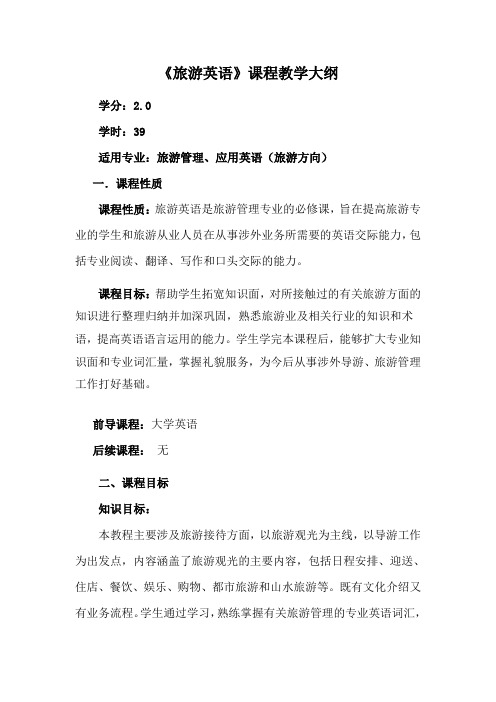
《旅游英语》课程教学大纲学分:2.0学时:39适用专业:旅游管理、应用英语(旅游方向)一.课程性质课程性质:旅游英语是旅游管理专业的必修课,旨在提高旅游专业的学生和旅游从业人员在从事涉外业务所需要的英语交际能力,包括专业阅读、翻译、写作和口头交际的能力。
课程目标:帮助学生拓宽知识面,对所接触过的有关旅游方面的知识进行整理归纳并加深巩固,熟悉旅游业及相关行业的知识和术语,提高英语语言运用的能力。
学生学完本课程后,能够扩大专业知识面和专业词汇量,掌握礼貌服务,为今后从事涉外导游、旅游管理工作打好基础。
前导课程:大学英语后续课程:无二、课程目标知识目标:本教程主要涉及旅游接待方面,以旅游观光为主线,以导游工作为出发点,内容涵盖了旅游观光的主要内容,包括日程安排、迎送、住店、餐饮、娱乐、购物、都市旅游和山水旅游等。
既有文化介绍又有业务流程。
学生通过学习,熟练掌握有关旅游管理的专业英语词汇,掌握常见的英文句型及重点语法,能听懂旅游业的常用英语口语,熟练朗读及拼写,能进行基本的英汉互译,能运用基本正确的英语进行对客交流服务,如:机场迎接游客、入住酒店,游览参观等。
技能目标:通过专题内容的集中训练,学生能够提高涉外旅游服务的英语听、说、读、写技能,能运用基本正确的英语进行对客交流服务。
素质目标:通过学习有关介绍中国文化及山水旅游活动的情景对话和真实语言材料,提高作为旅游工作者的旅游交际能力、文化素质和团队协作精神。
三、教学内容及具体要求Unit 1授课学时:4教学内容: Meeting Guests基本要求:1. To master the work procedure and task for a tour guide to meet guests.2. To make sure what a tour guide should prepare before meeting guests.3. To obtain the following abilities, such as meeting guests,making a welcome speech, transferring guests to the hotel, indicating the travel plan, and explaining scenery alongthe way.Unit 2授课学时:3教学内容:Hotel Check-in基本要求:1.To master the work procedure and content of a tour groupto check in.2.To grasp the importance of checking the schedule.3.To build up the ability of anticipating and dealing withunexpected events during check-in.Unit 3授课学时:3教学内容:Hotel Service基本要求:1.To get familiar with the procedure of catering service.2.To learn the food culture of tour destinations.3.To learn and practice the skills of dish ordering andpayment.Unit 4授课学时:4教学内容:Mountains and Waters Tours基本要求:1. To get familiar with the basic knowledge of mountain andwaters landscapes.2. To learn the skills of presenting mountain and waterslandscapes.3. To improve the ability to make up the guiding speech for mountain and water.landscapesUnit 5授课学时:3教学内容:Garden Tour基本要求:1.To get familiar with the basic knowledge on Chinese gardenlandscapes.2.To learn the skills of presenting Chinese gardenlandscapes.3.To learn to make up the guiding speech Chinese gardenlandscapes.Unit 6授课学时:3教学内容:Temple Tour基本要求:1.To grasp the basic knowledge of religious and culturallandscapes.2.To learn and practice the skills of presenting religiousand cultural landscapes.3.To learn to make up the guiding speech for religious andcultural landscapes.Unit 7授课学时:3教学内容:Mausoleum Tour基本要求:1.To get familiar with the basic knowledge of mausoleum.2.To learn and practice the skills of presenting mausoleum.3.To improve the ability to make up the guiding speech formausoleum tour.Unit 8授课学时:3教学内容: Shopping Service基本要求:1.To get familiar with the service procedure of shopping.2.To grasp the characteristics of local specialties indifferent tourist destinations.3.To know the precautions in the shopping service.Unit 9授课学时:4教学内容:Tourism Entertainment Services基本要求:1.To get familiar with the service procedure.2.To grasp local entertainment programs and characteristicsof them.3.To let the students develop a vocabulary related to thistopic.Unit 10授课学时:3教学内容:Handling Accidents and Complaints基本要求:1.To get familiar with the basic knowledge of travelingaccidents and complaints traveling accidents and complaints.2.To know the procedures of traveling accidents andcomplaints.3.To learn and practice the skills of traveling accidentsand complaints.4.To improve the basic ability to deal with minor accidents. Unit 11授课学时:3教学内容:Seeing off the Tour Group基本要求:1.To get familiar with the basic knowledge of seeing off thetour group.2.To learn the techniques of seeing off the tour group.3.To learn and practice the skills of traveling accidentsand complaints.4.To obtain and practice the ability to make up and deliverthe farewell speech.Unit 12授课学时:3教学内容:Services of Tour Leader基本要求:1.To learn the basic overview of the destination countries.2.To practice communication skills.3.To practice the ability of an independent overseas.4.To improve the ability to deal with emergencies abroad.四、教学手段及方法本课程的教学主要侧重于学生的实践能力,体现教,学,做融为一体,主要是要让学生掌握一些旅游有关的基本技能和技巧,并进行反复的练习,使学生在学习旅游相关知识的同时又提高旅游交际环境中综合应用能力和职业能力。
旅游英语》课程教学大纲
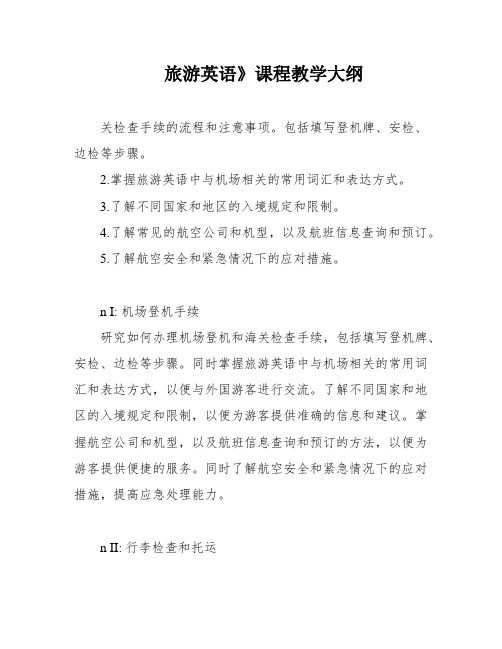
旅游英语》课程教学大纲关检查手续的流程和注意事项。
包括填写登机牌、安检、边检等步骤。
2.掌握旅游英语中与机场相关的常用词汇和表达方式。
3.了解不同国家和地区的入境规定和限制。
4.了解常见的航空公司和机型,以及航班信息查询和预订。
5.了解航空安全和紧急情况下的应对措施。
n I: 机场登机手续研究如何办理机场登机和海关检查手续,包括填写登机牌、安检、边检等步骤。
同时掌握旅游英语中与机场相关的常用词汇和表达方式,以便与外国游客进行交流。
了解不同国家和地区的入境规定和限制,以便为游客提供准确的信息和建议。
掌握航空公司和机型,以及航班信息查询和预订的方法,以便为游客提供便捷的服务。
同时了解航空安全和紧急情况下的应对措施,提高应急处理能力。
n II: 行李检查和托运研究如何进行行李检查和托运,包括行李限制和禁运物品的规定,以及如何打包和标记行李。
同时掌握旅游英语中与行李相关的常用词汇和表达方式,以便与外国游客进行交流。
了解不同航空公司和机场对行李的规定和收费标准,以便为游客提供准确的信息和建议。
掌握如何处理行李遗失和损坏的情况,提高应急处理能力。
n III: 在飞机上研究如何在飞机上进行涉外旅游服务接待,包括如何为游客提供餐饮和娱乐服务,如何处理紧急情况和突发事件。
同时掌握旅游英语中与飞机相关的常用词汇和表达方式,以便与外国游客进行交流。
了解不同航空公司和机型的服务和设施,以便为游客提供便捷的服务。
掌握如何处理飞行中的突发状况和紧急情况,提高应急处理能力。
n IV: 边防检查研究如何进行边防检查,包括海关和边检的规定和程序,以及如何填写相关表格和申请材料。
同时掌握旅游英语中与边防检查相关的常用词汇和表达方式,以便与外国游客进行交流。
了解不同国家和地区的出入境规定和限制,以便为游客提供准确的信息和建议。
掌握如何处理边防检查中的问题和突发情况,提高应急处理能力。
XXX I。
it covers job interviews XXX tourism products。
旅游英语大纲

旅游英语教学计划总课时:14个课时每节课:2课时任课教师:朱席Bill教学用书:英美佳旅游英语(课件)课程目标:为出国旅游人士量身定制,使学生能够应对旅途中多种场合的交流。
课程特点:实用为主,注重听说; 对常用词和常用句型的把握,启发学生学以致用。
注:计划书下划线部分为重点课例:Chapter 3: Preparations and Departure 旅行前奏Section 1: Planning the Tour计划旅行A.A Tour to San Francisco去旧金山玩B.Travel to America去美国旅行Section 2: Applying a Visa申请签证A.A Visa to Britain 签证去英国B.A Visa to America签证去美国Section 3: Booking Tickets预定机票A.Book a ticket预定机票B.Book a flight ticket预定单程/往返机票Section 4: Registering for Boarding办理登机A.Check-in for a flight办理登机手续B.Window seat靠窗的座位Section 5: On the Airplane在飞机上A.Food on the plane飞机上的食物B.Space for bags 放置行李Section 6: Transfer中途转机A.Help me Transfer please 请帮我转机B.To catch my connecting flight转下一趟航班Section 7: Retrieving the Luggage行李提取A.Claim the checked bags认领托运行李B.A bright red suitcase亮红色的行李箱Section 8: Security check过关检查A.Walk through the metal detector过安检B.Confiscate those cosmetics禁止登机的物品Section 9:Exchanging foreign currencies货币兑换A.Exchange currency 兑换现金B.Exchange US dollars兑换美元Chapter 4: Traffic 出行交通Section 1: Taking a bus乘公交车A.Bus going into Downtown乘公交车去市中心B.No. 19 bus 19路公交车Section 2: Taking a taxi乘出租车A.Taxi to central park打车去中央公园B.Taxi to the police station 打车到警察局Section 3: Taking the Subway 乘地铁A.A single ticket单程票B.Subway to Manhattan去曼哈顿的地铁Section 4: Taking a train乘坐火车A.Why do you choose train?为什么选择坐火车?B.The Non-stop train直达车Section 5: Riding a bike骑自行车A.Be careful when riding a bike骑自行车要注意B.Riding a bike is a good choice自行车是个好选择Section 6: Taking a ship乘船A.Take a cruise乘豪华邮轮B.The ship will stop at London船在伦敦靠岸Section 7: Driving a car自驾游A.Cool gift 最酷的礼物B.Favorite things about driving a car 开车最喜欢做的事Section 8: Renting a car租车A.Rent a simple car租用普通车B.Rent a limo 租用豪华加长车Chapter 5: Accommodation住宿Section 1: Reserving a room预订房间A.Reserve a standard room预定标间B.Reserve a King-sided bed预定特大床房间Section 2: Checking In登记入住A.Be late to check in比预订时间晚了怎么办B.Reservation for Parker帕克的预定Section 3: Arranging for the luggage安置行李A.Tip the bellboy给行李员小费B.Help guests with luggage帮客人拿行李Section 4: Room service 客房服务A.Lunch delivered to room把午饭送到房间B.Pre-order Breakfast预定早餐Section 5: Complaints酒店投诉A.Turn down the TV调低电视音量B.Still no towel for a shower没有浴巾Section 6: Checking out结账退房A.Check out 退房B.Check out by 2:00p.m.两点前退房Chapter 8: Sightseeing景区观光Section 1: Inquiring 闻讯A.Find the Golden gate bridge 找金门大桥B.Recommend some interesting places推荐好玩的地方Section 2: Going to a gallery去画廊A.Love going to art galleries画廊爱好者的天堂B.At the Renwick gallery在伦维克画廊Section 3: Visiting a museum参观博物馆A.The mummies木乃伊B.The American museum of natural history 美国自然历史博物馆Section 4:Visiting Former resident of celebrities拜访名人故居A.My favorite celebrity’s home我喜欢的名人住处B.Micheal Jackson’s previous home迈克尔杰克逊故居Section 5: Visiting a Famous university游览名校A.Visit Harvard university参观哈佛法学B.A long-history university 历史悠久的大学Section 6: At the scenic spot在景区A.What a great view!美丽的景色B.At death valley在死亡谷Section 7: Taking pictures拍照留念A.Take a picture拍照B.I have a nice camera我的相机Section 8: Having someone paged广播找人A.Have a child paged广播找孩子B.Paging Tom找TomChapter 9: Shopping商场购物Chapter 11: Chatting during the tour旅途畅聊Chapter 13: Dealing with problems状况处理。
旅游英语教学大纲
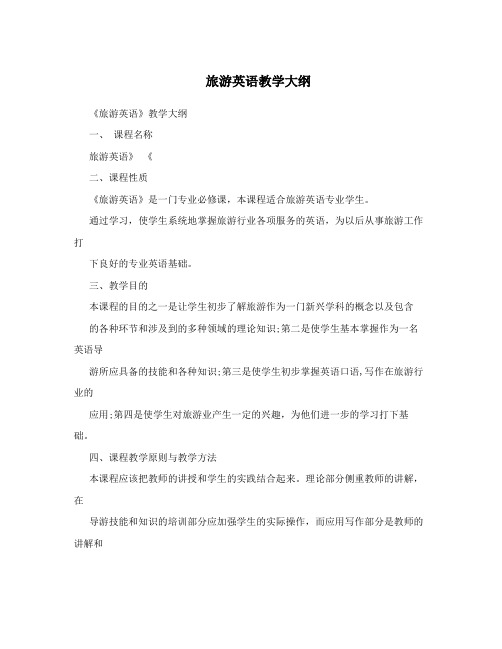
旅游英语教学大纲《旅游英语》教学大纲一、课程名称旅游英语》《二、课程性质《旅游英语》是一门专业必修课,本课程适合旅游英语专业学生。
通过学习,使学生系统地掌握旅游行业各项服务的英语,为以后从事旅游工作打下良好的专业英语基础。
三、教学目的本课程的目的之一是让学生初步了解旅游作为一门新兴学科的概念以及包含的各种环节和涉及到的多种领域的理论知识;第二是使学生基本掌握作为一名英语导游所应具备的技能和各种知识;第三是使学生初步掌握英语口语,写作在旅游行业的应用;第四是使学生对旅游业产生一定的兴趣,为他们进一步的学习打下基础。
四、课程教学原则与教学方法本课程应该把教师的讲授和学生的实践结合起来。
理论部分侧重教师的讲解,在导游技能和知识的培训部分应加强学生的实际操作,而应用写作部分是教师的讲解和学生的练习结合起来。
另外,此课程比较适合利用多媒体技术和各种光碟来讲解和介绍各种旅游知识。
五、课程时间及学分本课程开设时间为第3学期,每周4学时,共计64学时。
六、课程教学内容及基本要求本课程采用了《朗文旅游英语》为教学教材,共15个单元,本学期学习八个单元.主要内容如下:1. Unit1: All in a day’s workLanguage focus: adverbs of frequency, present simpleVocabulary: hotel jobs, daily duties, nationalitiesProfessional practice: exchange personal details, complete aregister2. Unit 2 Fly-drive holidaysLanguage focus: present continuousVocabulary: car hireProfessional practice: take a booking, deal with a telephone enquiry, hire a car, plan aholiday3. Unit 3 Table for twoLanguage focus: countable and uncountable nouns, some and any, much, many, a lot(of)Vocabulary: types of food, recording vocabulary, describing food, complaining aboutfoodProfessional practice: deal with a complaint, describe a traditional dish4. Unit 4 City toursLanguage focus: past simpleVocabulary: question words, giving directionsProfessional practice: give a guided tour, describe a building5. Unit 5 Water citiesLanguage focus: comparatives and superlativesVocabulary: hotel facilities, describing hotels, dealing with new wordsProfessional practice: write an email describing a hotel 6. Unit 6 Cruise shipsLanguage focus: present perfectVocabulary: cruises, cabin facilitiesProfessional practice: write a CV, write a covering letter, applyfor a job, interviewfor a job7. Unit 7 Service and safetyLanguage focus: modal verbs (requests and offers)Vocabulary: health and safety, on safariProfessional practice: check in a guest, give health and safety advice, write a letter ofapology8. Unit 8 East meets westLanguage focus: predictions and intentionsVocabulary: change wordsProfessional practice: exchange holiday plans, describe traditional gifts, create atourism development plan, give a presentation(1)七、教学实践环节要求要处理好旅游学科知识和英语语言知识的关系;要突出学生在旅游业中的实践能力,在教学环节中,要有意识培养学生运用英语技能来处理旅游业中遇到的各种问题。
旅游英语大纲
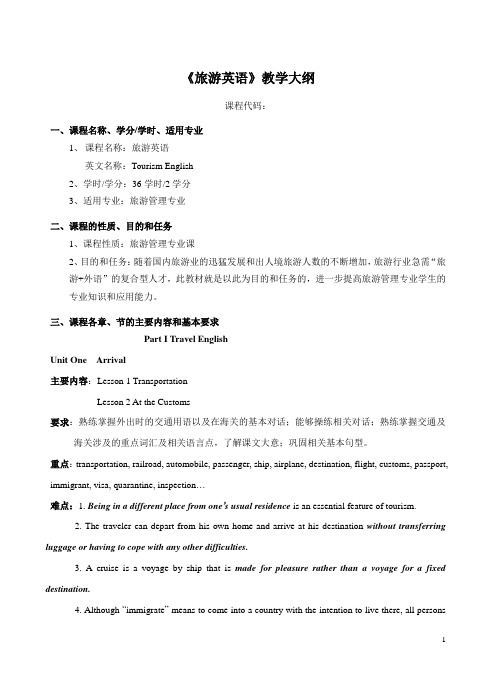
《旅游英语》教学大纲课程代码:一、课程名称、学分/学时、适用专业1、课程名称:旅游英语英文名称:Tourism English2、学时/学分:36学时/2学分3、适用专业:旅游管理专业二、课程的性质、目的和任务1、课程性质:旅游管理专业课2、目的和任务:随着国内旅游业的迅猛发展和出人境旅游人数的不断增加,旅游行业急需“旅游+外语”的复合型人才,此教材就是以此为目的和任务的,进一步提高旅游管理专业学生的专业知识和应用能力。
三、课程各章、节的主要内容和基本要求Part I Travel EnglishUnit One Arrival主要内容:Lesson 1 TransportationLesson 2 At the Customs要求:熟练掌握外出时的交通用语以及在海关的基本对话;能够操练相关对话;熟练掌握交通及海关涉及的重点词汇及相关语言点,了解课文大意;巩固相关基本句型。
重点:transportation, railroad, automobile, passenger, ship, airplane, destination, flight, customs, passport, immigrant, visa, quarantine, inspection…难点:1. Being in a different place from one’s usual residence is an essential feature of tourism.2. The traveler can depart from his own home and arrive at his destination without transferring luggage or having to cope with any other difficulties.3. A cruise is a voyage by ship that is made for pleasure rather than a voyage for a fixed destination.4. Although “immigrate” means to come into a country with the intention to live there, all personsentering a country must go through immigration, no matter how short their stay will be.5. The citizen also assures the country that the immigrant is not a criminal escaping from another country.Unit Two Sales Deal主要内容:Lesson 3 At the BankLesson 4 Mail ServiceLesson 5 Tourist ShoppingLesson 6 Travel Agency要求:熟练掌握旅游时在银行、邮寄服务、旅游购物及旅行社中的基本对话;能够操练相关对话;熟练掌握这几个方面的重点词汇及相关语言点,了解课文大意;巩固相关常用句型。
旅游英语教学大纲

------------学院《旅游英语》课程教学大纲课程编号:课程名称:旅游英语学时:120学时学分:适用专业:三年高职公共管理系旅游英语专业课程性质:专业课先修课程:公共英语,旅游学概论,客源国概况,中国旅游地理一、课程教学目标本课程是公共管理系旅游英语专业的一门专业必修课。
是旅游行业必备的职业技能课程。
通过教师对本课程的系统教学,使学生巩固加深英语基础知识,熟练掌握基本的旅游专业英文词汇和旅游英语的常用表达方式,具有基本的运用英语进行旅游业务方面的工作服务能力,特别是用英语进行简单的服务交际能力。
使学生熟悉旅游服务的各个工作流程与规范,掌握各工作流程的英语交际会话,能与外国游客进行简单日常的英语对话,能了解旅游行业基本知识,具备基本旅游服务技能。
二、课程内容及基本要求本课程开设两个学年,第一学期教学内容一共分为六个模块分别是:旅游咨询、机场接机、饭店住宿、旅游观光(1)、食物饮料和交通工具。
其中理论教学占48课时,随堂实训占12课时。
第二学期理论教学内容一共为六个个模块,分别是旅游购物、旅游娱乐、当地文化习俗旅游观光(2)、处理旅游突发事件和旅欧投诉。
其中理论教学占48课时,随堂实训占12课时。
本课程教学设计主要根据“模块化教学模式”下的任务型教学、情景教学的职业教育的培养模式来授课,以旅游基层服务为定位导向,以职业岗位能力、行业基本素质培养和职业资格证书获取为目标,开展实践性、开放性和职业性实践教学。
在教学中以完成任务为载体,通过情景模拟、案例分析、小组合作等活动项目来组织教学,倡导学生在项目活动中掌握初级岗位技能和旅游基本知识。
对本课程的教授本着以“实用为主,够用为度”为原则。
通过本课程的教学,使学生达到下列基本要求:1.进一步提高基础英语听说读写基本技能,掌握有关旅游服务接待中常用的英语专业词汇和常用表达方式。
2.加强角色扮演旅游情景对话的训练,提高听说能力,能与外国游客进行简单交流。
旅游英语教学大纲.doc
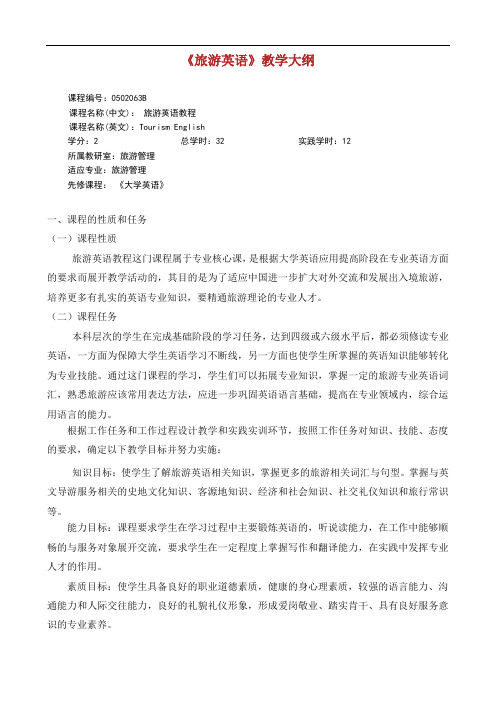
《旅游英语》教学大纲课程编号:0502063B课程名称(中文):旅游英语教程课程名称(英文):Tourism English学分:2 总学时:32 实践学时:12所属教研室:旅游管理适应专业:旅游管理先修课程:《大学英语》一、课程的性质和任务(一)课程性质旅游英语教程这门课程属于专业核心课,是根据大学英语应用提高阶段在专业英语方面的要求而展开教学活动的,其目的是为了适应中国进一步扩大对外交流和发展出入境旅游,培养更多有扎实的英语专业知识,要精通旅游理论的专业人才。
(二)课程任务本科层次的学生在完成基础阶段的学习任务,达到四级或六级水平后,都必须修读专业英语,一方面为保障大学生英语学习不断线,另一方面也使学生所掌握的英语知识能够转化为专业技能。
通过这门课程的学习,学生们可以拓展专业知识,掌握一定的旅游专业英语词汇,熟悉旅游应该常用表达方法,应进一步巩固英语语言基础,提高在专业领域内,综合运用语言的能力。
根据工作任务和工作过程设计教学和实践实训环节,按照工作任务对知识、技能、态度的要求,确定以下教学目标并努力实施:知识目标:使学生了解旅游英语相关知识,掌握更多的旅游相关词汇与句型。
掌握与英文导游服务相关的史地文化知识、客源地知识、经济和社会知识、社交礼仪知识和旅行常识等。
能力目标:课程要求学生在学习过程中主要锻炼英语的,听说读能力,在工作中能够顺畅的与服务对象展开交流,要求学生在一定程度上掌握写作和翻译能力,在实践中发挥专业人才的作用。
素质目标:使学生具备良好的职业道德素质,健康的身心理素质,较强的语言能力、沟通能力和人际交往能力,良好的礼貌礼仪形象,形成爱岗敬业、踏实肯干、具有良好服务意识的专业素养。
资质目标:通过理论知识强化和模拟现场导游实践,增强学生应对国家英语导游员资质考试的经验和信心,提高考试通过率,使学生顺利取得《国家英文导游员资格证书》。
二、课程的基本要求(一)激发学生自学兴趣,注重学生自学能力培养本课程在目标设定、教学过程、课程评价和教学资源的开发等方面突出以“激发学生自学兴趣,注重学生自学能力培养”的教学理念。
《旅游英语》教学大纲(参考优选)
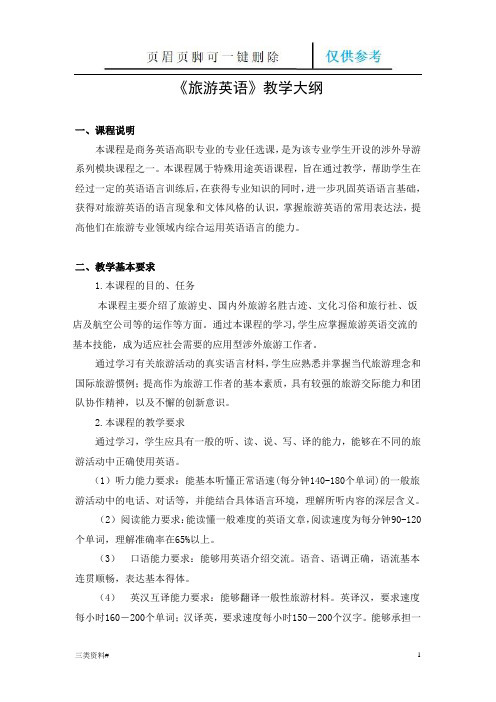
《旅游英语》教学大纲一、课程说明本课程是商务英语高职专业的专业任选课,是为该专业学生开设的涉外导游系列模块课程之一。
本课程属于特殊用途英语课程,旨在通过教学,帮助学生在经过一定的英语语言训练后,在获得专业知识的同时,进一步巩固英语语言基础,获得对旅游英语的语言现象和文体风格的认识,掌握旅游英语的常用表达法,提高他们在旅游专业领域内综合运用英语语言的能力。
二、教学基本要求1.本课程的目的、任务本课程主要介绍了旅游史、国内外旅游名胜古迹、文化习俗和旅行社、饭店及航空公司等的运作等方面。
通过本课程的学习,学生应掌握旅游英语交流的基本技能,成为适应社会需要的应用型涉外旅游工作者。
通过学习有关旅游活动的真实语言材料,学生应熟悉并掌握当代旅游理念和国际旅游惯例;提高作为旅游工作者的基本素质,具有较强的旅游交际能力和团队协作精神,以及不懈的创新意识。
2.本课程的教学要求通过学习,学生应具有一般的听、读、说、写、译的能力,能够在不同的旅游活动中正确使用英语。
(1)听力能力要求:能基本听懂正常语速(每分钟140-180个单词)的一般旅游活动中的电话、对话等,并能结合具体语言环境,理解所听内容的深层含义。
(2)阅读能力要求:能读懂一般难度的英语文章,阅读速度为每分钟90-120个单词,理解准确率在65%以上。
(3)口语能力要求:能够用英语介绍交流。
语音、语调正确,语流基本连贯顺畅,表达基本得体。
(4)英汉互译能力要求:能够翻译一般性旅游材料。
英译汉,要求速度每小时160-200个单词;汉译英,要求速度每小时150-200个汉字。
能够承担一般性旅游活动中的口译工作。
(5)综合素质要求:要求学生具有乐观、积极、向上的心理素质和勇于创新、不断更新自身知识体系的精神。
本课程采用普通高校专业英语教程系列中的《旅游专业英语实用教程》(邹晓燕等编著)为主要授课教材,以能力为本位,以学生为中心,灵活、多样、弹性的教学方法和以学习者的需求为教学基础,结合本土景点、景区及文化专题的内容进行教学。
关于旅行英语作文提纲模板
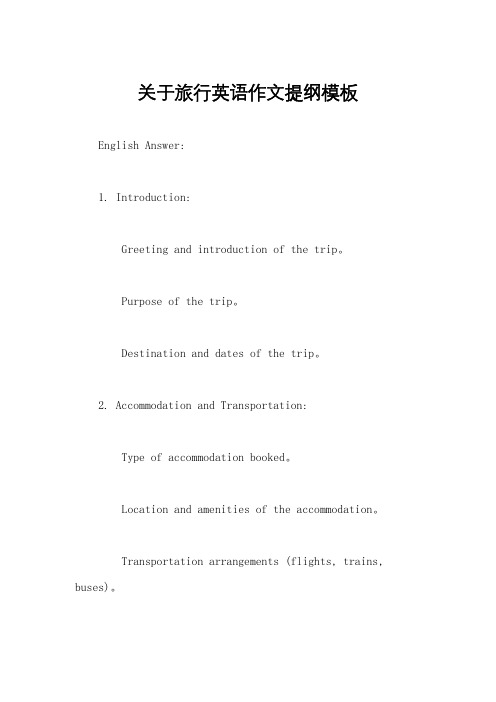
关于旅行英语作文提纲模板English Answer:1. Introduction:Greeting and introduction of the trip。
Purpose of the trip。
Destination and dates of the trip。
2. Accommodation and Transportation:Type of accommodation booked。
Location and amenities of the accommodation。
Transportation arrangements (flights, trains, buses)。
3. Itinerary:List of activities and events planned for each day。
Time and location of each activity。
Estimated expenses for each activity。
4. Packing List:Clothing and accessories。
Toiletries and essential items。
Electronics and communication devices。
5. Health and Safety:Necessary vaccinations and health precautions。
Travel insurance information。
Emergency contact information。
6. Culture and Customs:Research on local customs and traditions。
Appropriate attire and behavior。
Tips for interacting with locals。
7. Language Barrier:Level of language proficiency。
旅游大纲英语作文
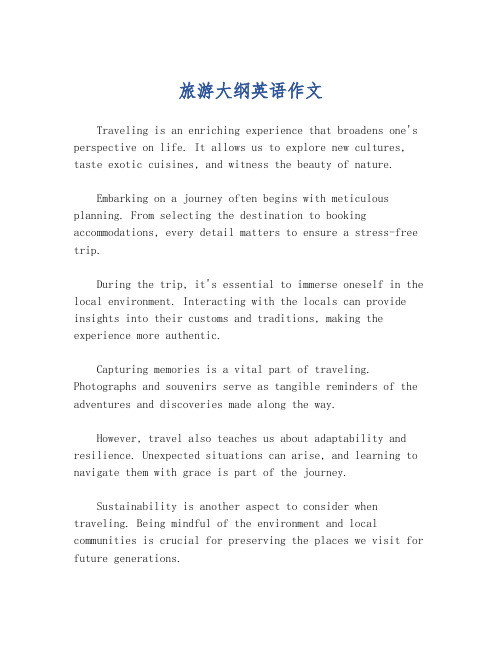
旅游大纲英语作文Traveling is an enriching experience that broadens one's perspective on life. It allows us to explore new cultures, taste exotic cuisines, and witness the beauty of nature.Embarking on a journey often begins with meticulous planning. From selecting the destination to booking accommodations, every detail matters to ensure a stress-free trip.During the trip, it's essential to immerse oneself in the local environment. Interacting with the locals can provide insights into their customs and traditions, making the experience more authentic.Capturing memories is a vital part of traveling. Photographs and souvenirs serve as tangible reminders of the adventures and discoveries made along the way.However, travel also teaches us about adaptability and resilience. Unexpected situations can arise, and learning to navigate them with grace is part of the journey.Sustainability is another aspect to consider when traveling. Being mindful of the environment and local communities is crucial for preserving the places we visit for future generations.Traveling solo can be a transformative experience, offering a chance for self-reflection and personal growth. It pushes us out of our comfort zones and encourages us to be independent.Lastly, sharing travel stories with friends and family upon returning home enriches social bonds. It allows us to relive the experiences and inspire others to embark on their own adventures.In conclusion, travel is a multifaceted activity that offers countless lessons and memories. It's a journey of discovery, both of the world and of oneself.。
旅游英语复习大纲
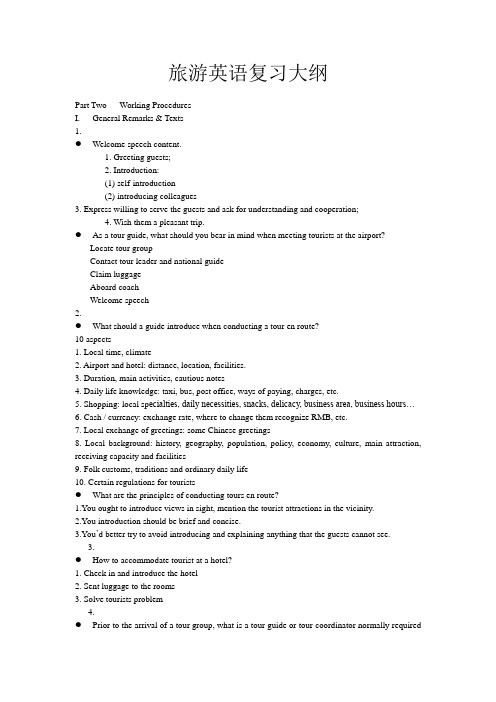
旅游英语复习大纲Part Two Working ProceduresI.General Remarks & Texts1.●Welcome speech content.1. Greeting guests;2. Introduction:(1) self-introduction(2) introducing colleagues3. Express willing to serve the guests and ask for understanding and cooperation;4. Wish them a pleasant trip.●As a tour guide, what should you bear in mind when meeting tourists at the airport?Locate tour groupContact tour leader and national guideClaim luggageAboard coachWelcome speech2.●What should a guide introduce when conducting a tour en route?10 aspects1. Local time, climate2. Airport and hotel: distance, location, facilities.3. Duration, main activities, cautious notes4. Daily life knowledge: taxi, bus, post office, ways of paying, charges, etc.5. Shopping: local sp ecialties, daily necessities, snacks, delicacy, business area, business hours…6. Cash / currency: exchange rate, where to change them recognize RMB, etc.7. Local exchange of greetings: some Chinese greetings8. Local background: history, geography, population, policy, economy, culture, main attraction, receiving capacity and facilities9. Folk customs, traditions and ordinary daily life10. Certain regulations for tourists●What are the principles of conducting tours en route?1.You ought to introduce views in sight, mention the tourist attractions in the vicinity.2.You introduction should be brief and concise.3.You’d better try to avoid introducing and explaining anything that the guests cannot see.3.●How to accommodate tourist at a hotel?1. Check in and introduce the hotel2. Sent luggage to the rooms3. Solve tourists problem4.●Prior to the arrival of a tour group, what is a tour guide or tour coordinator normally requiredto do?Make a detailed study of the reception program and draft a preliminary itinerary withreference to the age-bracket, food preference, religious taboos, occupations and tastes ofall the group members.5.●Attention is paid to the aesthetic appreciation of…(last sentence of p97)Attention is paid to the aesthetic appreciation of food, and careful consideration is givento the aroma and appearance of a dish as well as its flavor.●What are the four aspects of Chinese culinary art?The first is the preparation of ingredients.The second is cutting and garnishing.The third is temperature.The last aspect is varied cooking techniques.●What are the respective features of the Four Cuisines in Chinese?Lu CuisineA. Shangdong food: light and mellow, emphasis on aroma, freshness, crispness and tenderness, served in clear or creamer soup.B. Beijing food: influenced by ―Confucius Family Dishes‖, exquisite selection of ingredients, fine cutting and pure seasoning; rich but not greasy, light but not skimpy, skillful in preparing delicacies of every kind.Yue Cuisine:Hot climate — dishes fresh, tender, lightly seasoned, all ingredients usedCooked with a minimum amount of time and an exact degree of heatSichuan CuisineChinese – Mexican foodHuaiyang CuisineSweet, emphasized on cutting technique and temperature controlA. Shanghai food: rich, sweet, colorful with freshly picked ingredients such as fish and shellfish; tastes are salty, pickled, sweet and sourB. Jiangzhe food: use poultry and seafood.6.●What are the tips for tour guides to follow when accompanying tourists to goshopping?Give a brief account of the shopping arcade.Render assistance in their choice of goods.Help them cash traveler’s cheques.Make arrangements for the packaging or shipping.7.●List some typical art forms and recreational activities in China?Operas, acrobatic shows, folk dances, qiqong, martial arts●What is Beijing Opera?Beijing Opera combines many art forms, apart from singing and recitation, it includestraditional Chinese music ,poetry ,dancing ,pantomime,elaborate costumesandmake-up ,acrobatics and martial arts.It has nothing in common with the operaoroperettas of the West,and it is much more than mere opera or oroperettas in the usualsense.●What are the criteria of an all-round top-notch Beijing Opera performer?An all-round top-notch Beijing Opera performer, must be attractive when make-up ,ofpleasing physical proportions, with a pair of expressive eyes and a rich variety of facialexpressions.●What is every movement on the stage required? (p123)Every movement on the stage gracefully and precisely ,and every pose assumed at theend of a movement makes the performer resemble a piece of well-executed sculpture●What is Chinese legendary dragon? What did people in ancient times believe aboutdragons?China’s legendary dragon is not the monster encountered in the western mythology,but abenign creature symbolizing good fortune.In ancient times , dragon were believed to bring rain in times of drought,keep awaymisfortune and bring good luck to all who invoke its help.8.●What are the contents of a farewell speech?The contents of a farewell speech depend on the special features of a specific group ,butthe speech is usually flooded wiith beautiful memories and good wishes.9.●How to deal with a tourist’s complaints step by step?1. Listen to the complainer patiently and politely2. Make a short apology and comfort the complainer3. Make a summary of the complaint to ensure the understanding of both sides4. Tell the solutionSituation A: if you can help, just inform the complainer your actions and how soonSituation B: if beyond your ability, transfer to others, tell who will do and keep the feedbackeful sentence and sentence framesPart Three Tourist Attractions1.●How are Chinese three major topographic regions divided?China’s three major topographic regions are clearly marked by its mountains.The first region contains the Tibetan Plateau and other less dramatic highlands.The second region is a highland region marked by extensive basin areas,The third region is the lowlands, east of the Great Xing’an, Taihang and Wushan mountains.●What are China’s Five Holy Mountains? Where are they? What are they famous for?Mount Tai in ShandongMount Hua in Xi’an, Shaanxi. It is best known for its sheer cliffs and has for centuries been an attraction to climbers.Mount Song in Henan. It is world famous because of the popularization of China’s martial arts.Mount Heng in HunanMount Heng in Datong, Shanxi●Where are China’s Four Buddhist mountains? What Bodhisattvas are respectivelyworshiped in each of the mountains?1. Mount Wutai in Shanxi – Bodhisattva of Wisdom2. Mount Putuo in Zhejiang – Goddess of Mercy3. Mount Jiuhua in Anhui - Bodhisattva of Dizang4. Mount Emei in Sichuan - Bodhisattva of Universal Benevolence2.●What are the distribution categories of China’s rivers?P1733.●p190 Name some forms of ancient defensive projects in China.City walls, moats, fortresses, strongholds, castles.●P192 Paragraph 2: Gatetowers, gateways, … a strategically complete and impenetrabledefensive system.Gatetowers, gateways, watch-towers, remparts, and battlements were constructed so that the walls formed a strategically complete and impenetrable defensive system.●What wall building techniques were developed to strengthen strategic and defensivecapabilities in Ming and Qing dynasties? P1934.●What were the dwellings of primitive men? p204The dwellings of primitive men were natural caves.●What are the two prominent distinguishing features of classical Chinese architecture?P205The timber frame structure and bracket system or dougong.●What are the advantages and disadvantages of the timber frame structure?●How was the Chinese people’s social status in the past indicated by theconstructing and decorating systems?1. The height of the terrace2. The number of bays (odd bays)3. The use of bracket system:4. The eaves5. Architectural paintings●p221 paragraph 2 ― Different from classical European gardens, …landscape on a smallerscale.‖Different from classical European gardens, in which geometric pattern dominates. Chinese gardens are made to resemble natural landscape on a smaller scale.●Most imperial gardens have three sections: … p222Most imperial gardens have three sections: the administrative section, residential section and recreational section.●How to appreciate classical Chinese gardens? 223-2241. It is the reconstruction of nature.2. Influenced by some art forms.3. Technical methods to create the mood of art, implicit meaning and harmony between manand nature.5.●What are the most important and representative buildings inside a Buddhist templecomplex? P238The main entrance gate, the bell and drum towers, Tianwang Dian, or the Hall of the Celestial Kings, the Hall of the Buddha, and the pagoda.●What does lotus blossom mean in Buddhism? P239Symbolizes absolute beauty, purity and knowledge.●What does Buddha, pusa, arhats mean? P240-241What is Buddha?A. the most important hall to enshrine Buddha;B. lotus blossom, the meaning;C. statues of Buddha* Buddha – nirvanaPusa: These are saints who gained enlightenment but have come back to the word to help other people attain it, too.Arhats – saints who have achieved nirvana, philosophers●What’s the function of a Buddhist pagoda? What are the styles of the pagoda? P242 The underground hall is used to store sacred relics.Styles: multieave style, pavilion style, Lamaist style, etc.7.●What were the typical features of the Chinese earliest tombs in the Shang Dynasty?The millennia-old cross-shaped underground pit tombs: ( from the Shang Dynasty) Features:A. cross-shaped underground pitB. no mounds on topC. wooden burial chamberD. sacrificed persons●When were there mounds on top of all rulers’ burial places?p257●What were the renovations of imperial tombs in the Han Dynasty?Building material: from wood to bricks(3rd – 2nd century BC)A. allow extravagant decorations;B. reproduce the earthly life;C. burial complexes to supersede underground pits (the Han Dynasty)●What were the renovations of imperial tombs in the Ming Dynasty?Innovations of the Ming Tombs1. a complex in front of each tomb2. a single holy path with stone sculptures3. 3 parts of each burial site: Sacrificial hall, Stele tower, Treasure mound8.●What are the most representative traditional Chinese festivals? When do they fall intoaccording to Chinese lunar calendar?Spring Festival the lunar New YearThe Lantern Festival the fifteenth day of the first lunar monthThe Dragon Boat Festival the fifth day of the fifth monthMid-autumn Festival the fifteenth day of the eighth lunar month●Describe one of the Chinese festivals.P273-27810.●What are the five major script forms of Chinese calligraphy? What is generally reckonedto be a dramatic change in the form of Chinese characters? P307Seal clerical standard semi-cursive and cursiveThe evolution from the seal script to the clerical script●What is the general difference of Chinese paintings and European paintings? P309Chinese painting Vs. European painting:lines to create images - color and light so that o ne sees no ―lines‖ and only ―areas‖●Why are Chinese calligraphy and painting called sister arts?1. the same brush, paper and ink2. rely on lines3. the relationship between a Chinese ideograph and a pictorial graph4. use of colors5. a painter is a calligrapher and vice versa●How to appreciate Chinese paintings?P3101. the limitation of design2. a good painter often leaves much room for the viewers to indulge in wonderment and imagination* concept of void, based on the Taoist speculations of non-existence3. a different artistic language from that of the Westerners4. one should paint the picture from the memory5. not restricted by the focal point but the dispersed points in its perspective (shifting perspective)since they want to break away from the restrictions of time and spaceIII.Translation1.p66 @22.p105 @53.p118 @44.p129 @25.p170 @16.p202 @37.p218 @28.p235 @19.p269 @1。
旅行英文作文大纲范文
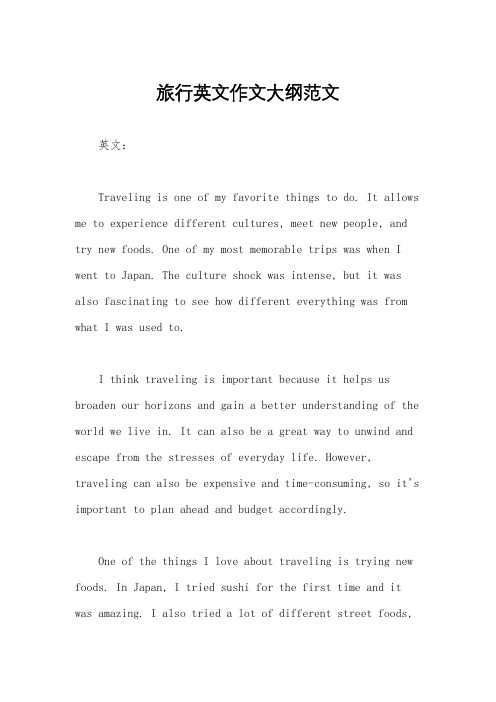
旅行英文作文大纲范文英文:Traveling is one of my favorite things to do. It allows me to experience different cultures, meet new people, and try new foods. One of my most memorable trips was when I went to Japan. The culture shock was intense, but it was also fascinating to see how different everything was from what I was used to.I think traveling is important because it helps us broaden our horizons and gain a better understanding of the world we live in. It can also be a great way to unwind and escape from the stresses of everyday life. However, traveling can also be expensive and time-consuming, so it's important to plan ahead and budget accordingly.One of the things I love about traveling is trying new foods. In Japan, I tried sushi for the first time and it was amazing. I also tried a lot of different street foods,like takoyaki and okonomiyaki. It was a great way to experience the local culture and cuisine.中文:旅行是我最喜欢做的事情之一。
- 1、下载文档前请自行甄别文档内容的完整性,平台不提供额外的编辑、内容补充、找答案等附加服务。
- 2、"仅部分预览"的文档,不可在线预览部分如存在完整性等问题,可反馈申请退款(可完整预览的文档不适用该条件!)。
- 3、如文档侵犯您的权益,请联系客服反馈,我们会尽快为您处理(人工客服工作时间:9:00-18:30)。
《实用旅游英语听说》课程教学大纲
一、课程性质与作用
(一)课程性质与作用
《旅游英语口语》课程是一门为旅游管理专业学生设置的针对性强、注重实用性的专业必修课程。
本课程着重培养学生在导游、旅游管理、旅游营销等工作岗位中所需的涉外语言交流、迎宾接待、处理涉外旅游事务等专业能力,主要涵盖导游服务场所的员工服务基本程序,包括酒店接待基本知识、旅游住宿与交通、游客接待与服务、景区点讲解与服务等基本知识和工作流程。
通过本课程的学习,学生能够了解旅游相关的专业用语、导游、酒店和餐饮服务的流程,能够运用所学专业词汇和句型结构较为顺利地完成涉外旅游场景下的英语交际。
(二)课程设计思路
本课程是按照旅游服务与管理的基本工艺流程与环节,循序渐进,深入浅出,通俗易懂,使学生容易理解与操作;本课程注重学生记忆、动耳听、动口说的应用能力的培养,以及专业英语应用场景中使用英语的策略的能力的培养,理解旅游涉外工作中的专业英语的基本概念,了解旅游业最前沿的知识。
本课程根据涉外旅游工作过程导向课程开发的思路重构课程学习情景,教学目标以学生为本、以能力为本、以项目导向,以实用、够用、会用为原则培养能够胜任涉外旅游一线工作岗位的高素质人才。
二、课程目标
《旅游英语口语》作为旅游管理专业的英语课程,其教学任务就在于帮助旅游管理专业的学生熟练掌握旅游的专业用语、导游、酒店和餐饮服务的流程,能够运用所学专业词汇和句型结构较为顺利地完成涉外旅游场景下的英语交际。
本课程在教学过程中,注重知识性和趣味性相结合,在学生已经具备一定的英语语言基础之上,为其今后从事旅游及相关行业工作奠定良好的基础。
针对旅游英语课程的实用性,突出任务性原则,课程的教学始终结合旅行社导游服务的管理理念、运作流程和规范用语,在对学生进行专业知识和语言点的传授的基础上,注重对其灵活运用语言的能力,尤其是交际能力的培养,目的在于使旅游专业的学生成为具备较扎实的英语基础,较好的听说能力的旅游人才。
具体目标如下:
(一)知识目标
依据课程标准和教材内容,以及大二学生的认知水平,确立知识目标为:
(1)了解导游人员的相关业务知识;
(2)熟知具体场景的旅游英语口语表达;
(3)掌握旅游英语中的专业词汇,以及在接待,带团中常用到的句型。
(二)能力目标
根据大二学生观察、思考、分析和判断能力的发展阶段,确立能力目标是:
(1)在授课过程中,让学生学习专业的词汇及句型,通过练习使学生把英语作为工具,在从事导游工作中具有一定的交际能力,具备扎实的专业基础知识。
(2)培养学生的实践的能力,使学生更好的掌握所学知识。
(三)素质目标
培养训练学生具有基本的政治素质,有事业心、责任感和良好的服务意识,以能力为中心,素质教育为目的,突出高职高专教育特色,培养适合社会主义市场经济建设需要的具有较强能力的高等应用型旅游英语专业人才,以满足社会及职业的多样化需求。
三、教学内容及要求
本课程使用《实用旅游英语听说教程》,内容贴近工作岗位实际,以任务为主线,既重视旅游专业知识的传授,亦注重英语听说能力的培养。
全书附有录音文本和录音磁带。
本书共有26个教学单元,内容不超出同步基础教程的词汇和语法范围。
四、课程实施建议
(一)教材建议
1、参考教材:
教材名称:《实用旅游英语听说教程》
作者:郭学英
出版社:旅游教育出版社
出版年月:2016 年 5 月出版
2、其它参考资料:
(1)《新编大学实用英语教程》作者:林立等主编出版社:教育科学出版社
出版年月:2016 年 1月出版
(2)《牛津高阶英汉双解词典(第7版)》主编:[英] Sally Wehmeier
出版社:牛津大学出版社出版时间:2009年04月本印时间:2013年08月
(二)教学建议
本课程是英语听说能力训练课程,与其它课程相辅相成。
本课程教学内容安排以单元教学为教学单位,各单元由易到难,逐次增加难度及训练强度。
在教学过程中,每单元可视不同情况采用不能教学方法和手段;教师应注意从培养学生的听、说技能入手,根据不同的内容与要求从多种角度对学生进行有层次的训练。
要求良好的师生互动,生生互动,学生参与
语言实践。
(三)教学方法与手段
灵活处理教材,设计符合实际的教学模式。
(1)听力训练:每次听两个对话或两篇文章,让学生达到听懂并能复述每句话的水平。
(2)听力训练重、难点:每个词和每句话都得听懂是难点。
(3)扩展性训练:提供了听单词、听句子、回答问题等训练项目。
灵活采用多种教学方法和现代教育技术,改变了传统的教学手段、模式、方法,强化了以学生为主体的主动学习,注重学生的创造和实际能力的培养,注重培养学生实际分析问题、解决问题的能力。
(四)课程教学资源
坚持传统课堂教学与多媒体教学结合。
英语读写译基础教程既要注重教师在英语教学上的传统优势,又要充分利用现代化多媒体教学手段辅助教学,使大学英语基础教程教学更加形象、直观、生动、活泼,同时信息量增大,省时、省力、便捷、灵活,方便学生课外拓展学习和复习。
教材和英语听说教程学习视频,英语听力专题网站,沪江英语网等相关英语学习网站相结合,为学生提供最实用的知识。
五、考核与评价
《旅游英语口语》课程实行百分制计算方法,考试形式为笔试。
笔试实行闭卷考试。
1. 平时成绩:60%(包括出勤、课堂表现、作业)
2. 期末笔试:40%
六、有关说明
此大纲是依据2018人才培养方案编写,具体到上课环节要根据学生实际情况因材施教。
